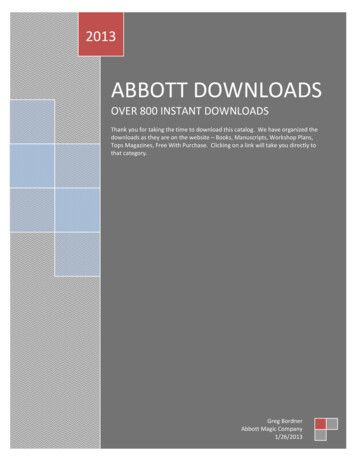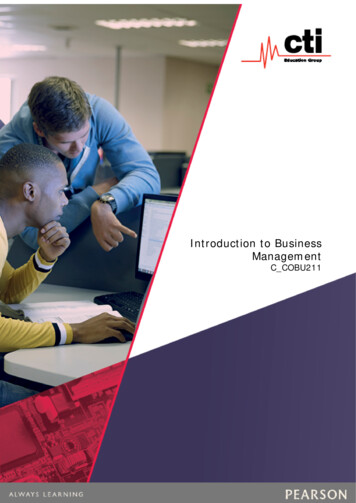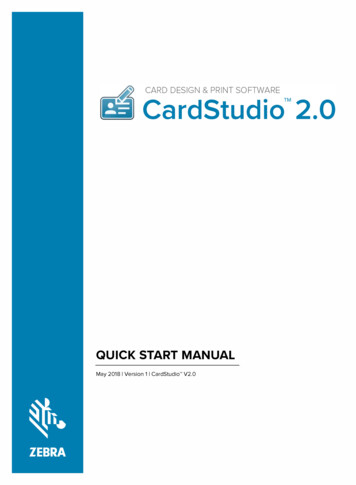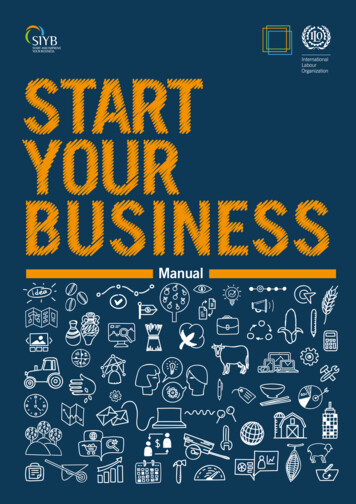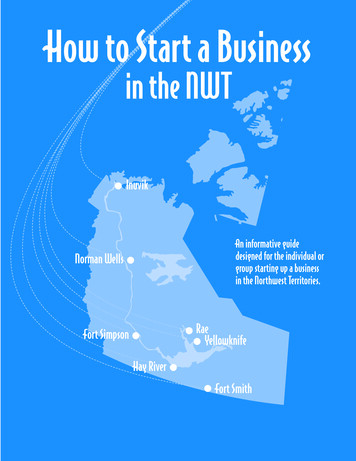
Transcription
How to Start a Businessin the NWTInuvikAn informative guidedesigned for the individual orgroup starting up a businessin the Northwest Territories.Norman WellsRaeYellowknifeFort SimpsonHay RiverFort Smith
How to Start a Business in the NWTTable of ContentsA message from the Canada/NWT Business Service Centre . . . . . . . . . . . . . . . . . . . . . . . . . . . . . . . .3Chapter 1: The Canada/NWT Business Service CentreYour source for business information . . . . . . . . . . . . . . . . . . . . . . . . . . . . . . . . . . . . . . . . . . . . . . . . . . . . . . . . . .4Products and services . . . . . . . . . . . . . . . . . . . . . . . . . . . . . . . . . . . . . . . . . . . . . . . . . . . . . . . . . . . . . . . . .4Internet services . . . . . . . . . . . . . . . . . . . . . . . . . . . . . . . . . . . . . . . . . . . . . . . . . . . . . . . . . . . . . . . . . . . . . . . .5Business Start-up Assistant . . . . . . . . . . . . . . . . . . . . . . . . . . . . . . . . . . . . . . . . . . . . . . . . . . . . . . . . . . . . .5Interactive Business Planner . . . . . . . . . . . . . . . . . . . . . . . . . . . . . . . . . . . . . . . . . . . . . . . . . . . . . . . . . . . . .5Online Small Business Workshop . . . . . . . . . . . . . . . . . . . . . . . . . . . . . . . . . . . . . . . . . . . . . . . . . . . . . . . . .5Chapter 2: Getting StartedSo you want to be an entrepreneur . . . . . . . . . . . . . . . . . . . . . . . . . . . . . . . . . . . . . . . . . . . . . . . . . . . . . . . . .6Why do you want to get into business? . . . . . . . . . . . . . . . . . . . . . . . . . . . . . . . . . . . . . . . . . . . . . . . . . . . .6Assessing your personal strengths and weaknesses . . . . . . . . . . . . . . . . . . . . . . . . . . . . . . . . . . . . . . . . . . . . . .6Assessing your personal risk tolerance . . . . . . . . . . . . . . . . . . . . . . . . . . . . . . . . . . . . . . . . . . . . . . . . . . . . . .6Assessing your financial resources . . . . . . . . . . . . . . . . . . . . . . . . . . . . . . . . . . . . . . . . . . . . . . . . . . . . . . . . .7Recognizing the risks . . . . . . . . . . . . . . . . . . . . . . . . . . . . . . . . . . . . . . . . . . . . . . . . . . . . . . . . . . . . . . . . .7Strategies for reducing risk . . . . . . . . . . . . . . . . . . . . . . . . . . . . . . . . . . . . . . . . . . . . . . . . . . . . . . . . . . . . . .8Chapter 3: Making Your Business Idea a RealityWays to get into business . . . . . . . . . . . . . . . . . . . . . . . . . . . . . . . . . . . . . . . . . . . . . . . . . . . . . . . . . . . . . . . . .9Starting from scratch . . . . . . . . . . . . . . . . . . . . . . . . . . . . . . . . . . . . . . . . . . . . . . . . . . . . . . . . . . . . . . . . . .9Buying an existing business . . . . . . . . . . . . . . . . . . . . . . . . . . . . . . . . . . . . . . . . . . . . . . . . . . . . . . . . . . . . .9Franchising . . . . . . . . . . . . . . . . . . . . . . . . . . . . . . . . . . . . . . . . . . . . . . . . . . . . . . . . . . . . . . . . . . . . . . . .10Start? Buy? Franchise? Key considerations . . . . . . . . . . . . . . . . . . . . . . . . . . . . . . . . . . . . . . . . . . . . . . . . .11Forms of business organization . . . . . . . . . . . . . . . . . . . . . . . . . . . . . . . . . . . . . . . . . . . . . . . . . . . . . . . . . . . . . .11Sole proprietorship . . . . . . . . . . . . . . . . . . . . . . . . . . . . . . . . . . . . . . . . . . . . . . . . . . . . . . . . . . . . . . . . . .11Partnership . . . . . . . . . . . . . . . . . . . . . . . . . . . . . . . . . . . . . . . . . . . . . . . . . . . . . . . . . . . . . . . . . . . . . . . .12Corporation or limited company . . . . . . . . . . . . . . . . . . . . . . . . . . . . . . . . . . . . . . . . . . . . . . . . . . . . . . . . .12Co-operative . . . . . . . . . . . . . . . . . . . . . . . . . . . . . . . . . . . . . . . . . . . . . . . . . . . . . . . . . . . . . . . . . . . . . .13To incorporate or not? Key considerations . . . . . . . . . . . . . . . . . . . . . . . . . . . . . . . . . . . . . . . . . . . . . . . . . .14Chapter 4: Developing a Business PlanYour business plan . . . . . . . . . . . . . . . . . . . . . . . . . . . . . . . . . . . . . . . . . . . . . . . . . . . . . . . . . . . . . . . . . . . . .15Contents of your business plan . . . . . . . . . . . . . . . . . . . . . . . . . . . . . . . . . . . . . . . . . . . . . . . . . . . . . . . . . .15Executive summary . . . . . . . . . . . . . . . . . . . . . . . . . . . . . . . . . . . . . . . . . . . . . . . . . . . . . . . . . . . . . . . . . . . . . .15Mission statement . . . . . . . . . . . . . . . . . . . . . . . . . . . . . . . . . . . . . . . . . . . . . . . . . . . . . . . . . . . . . . . . . . . . . .15Company overview . . . . . . . . . . . . . . . . . . . . . . . . . . . . . . . . . . . . . . . . . . . . . . . . . . . . . . . . . . . . . . . . . .16Strategic business objectives . . . . . . . . . . . . . . . . . . . . . . . . . . . . . . . . . . . . . . . . . . . . . . . . . . . . . . . . . . . .16Business and market environment . . . . . . . . . . . . . . . . . . . . . . . . . . . . . . . . . . . . . . . . . . . . . . . . . . . . . . . . .17Market plan . . . . . . . . . . . . . . . . . . . . . . . . . . . . . . . . . . . . . . . . . . . . . . . . . . . . . . . . . . . . . . . . . . . . . . .19Financial plan . . . . . . . . . . . . . . . . . . . . . . . . . . . . . . . . . . . . . . . . . . . . . . . . . . . . . . . . . . . . . . . . . . . . . .19Financial projections . . . . . . . . . . . . . . . . . . . . . . . . . . . . . . . . . . . . . . . . . . . . . . . . . . . . . . . . . . . . . . . . .21Financial statements . . . . . . . . . . . . . . . . . . . . . . . . . . . . . . . . . . . . . . . . . . . . . . . . . . . . . . . . . . . . . . . . . .22Analyzing financial statements . . . . . . . . . . . . . . . . . . . . . . . . . . . . . . . . . . . . . . . . . . . . . . . . . . . . . . . . . . .251
How to Start a Business in the NWTChapter 5: Financing Your BusinessEquity capital . . . . . . . . . . . . . . . . . . . . . . . . . . . . . . . . . . . . . . . . . . . . . . . . . . . . . . . . . . . . . . . . . . . . . .27Private sources of funds . . . . . . . . . . . . . . . . . . . . . . . . . . . . . . . . . . . . . . . . . . . . . . . . . . . . . . . . . . . . . . .27Government financial assistance . . . . . . . . . . . . . . . . . . . . . . . . . . . . . . . . . . . . . . . . . . . . . . . . . . . . . . . . .27Commercial loans . . . . . . . . . . . . . . . . . . . . . . . . . . . . . . . . . . . . . . . . . . . . . . . . . . . . . . . . . . . . . . . . . . .28Other sources of funding . . . . . . . . . . . . . . . . . . . . . . . . . . . . . . . . . . . . . . . . . . . . . . . . . . . . . . . . . . . . . .29A final word . . . . . . . . . . . . . . . . . . . . . . . . . . . . . . . . . . . . . . . . . . . . . . . . . . . . . . . . . . . . . . . . . . . . . . . . .29Chapter 6: Regulatory and Licensing AgenciesWorkers’ Compensation . . . . . . . . . . . . . . . . . . . . . . . . . . . . . . . . . . . . . . . . . . . . . . . . . . . . . . . . . . . . . .30Business License . . . . . . . . . . . . . . . . . . . . . . . . . . . . . . . . . . . . . . . . . . . . . . . . . . . . . . . . . . . . . . . . . . .30Business Registration . . . . . . . . . . . . . . . . . . . . . . . . . . . . . . . . . . . . . . . . . . . . . . . . . . . . . . . . . . . . . . . . .30Business Number . . . . . . . . . . . . . . . . . . . . . . . . . . . . . . . . . . . . . . . . . . . . . . . . . . . . . . . . . . . . . . . . . . .30Payroll Tax . . . . . . . . . . . . . . . . . . . . . . . . . . . . . . . . . . . . . . . . . . . . . . . . . . . . . . . . . . . . . . . . . . . . . . . .31Labour Standards . . . . . . . . . . . . . . . . . . . . . . . . . . . . . . . . . . . . . . . . . . . . . . . . . . . . . . . . . . . . . . . . . . .31Business Incentive Policy . . . . . . . . . . . . . . . . . . . . . . . . . . . . . . . . . . . . . . . . . . . . . . . . . . . . . . . . . . . . . .31Other considerations . . . . . . . . . . . . . . . . . . . . . . . . . . . . . . . . . . . . . . . . . . . . . . . . . . . . . . . . . . . . . . . .32Appendix A: Sources of Business Information and AdvicePublic sources . . . . . . . . . . . . . . . . . . . . . . . . . . . . . . . . . . . . . . . . . . . . . . . . . . . . . . . . . . . . . . . . . . . . . . . .33Government of the Northwest Territories . . . . . . . . . . . . . . . . . . . . . . . . . . . . . . . . . . . . . . . . . . . . . . . . . . .33Government of Canada . . . . . . . . . . . . . . . . . . . . . . . . . . . . . . . . . . . . . . . . . . . . . . . . . . . . . . . . . . . . . .33Private sources . . . . . . . . . . . . . . . . . . . . . . . . . . . . . . . . . . . . . . . . . . . . . . . . . . . . . . . . . . . . . . . . . . . . . . . .34Banks . . . . . . . . . . . . . . . . . . . . . . . . . . . . . . . . . . . . . . . . . . . . . . . . . . . . . . . . . . . . . . . . . . . . . . . . . . .34Consultants . . . . . . . . . . . . . . . . . . . . . . . . . . . . . . . . . . . . . . . . . . . . . . . . . . . . . . . . . . . . . . . . . . . . . . .34Accounting Firms . . . . . . . . . . . . . . . . . . . . . . . . . . . . . . . . . . . . . . . . . . . . . . . . . . . . . . . . . . . . . . . . . . .34Law firms . . . . . . . . . . . . . . . . . . . . . . . . . . . . . . . . . . . . . . . . . . . . . . . . . . . . . . . . . . . . . . . . . . . . . . . .34Other sources . . . . . . . . . . . . . . . . . . . . . . . . . . . . . . . . . . . . . . . . . . . . . . . . . . . . . . . . . . . . . . . . . . . . . . . .35Business organizations in the NWT . . . . . . . . . . . . . . . . . . . . . . . . . . . . . . . . . . . . . . . . . . . . . . . . . . . . . . .35Publications . . . . . . . . . . . . . . . . . . . . . . . . . . . . . . . . . . . . . . . . . . . . . . . . . . . . . . . . . . . . . . . . . . . . . . .35Appendix B: Programs for Business. . . . . . . . . . . . . . . . . . . . . . . . . . . . . . . . . . . . . . . . . . . . . . . . . . .36Table 1: Start-up and expansion programs . . . . . . . . . . . . . . . . . . . . . . . . . . . . . . . . . . . . . . . . . . . . . . . . . . .36Table 2: Management training and employment programs . . . . . . . . . . . . . . . . . . . . . . . . . . . . . . . . . . . . . . . .38Table 3: Market development programs . . . . . . . . . . . . . . . . . . . . . . . . . . . . . . . . . . . . . . . . . . . . . . . . . . . .39Appendix C: Contacts. . . . . . . . . . . . . . . . . . . . . . . . . . . . . . . . . . . . . . . . . . . . . . . . . . . . . . . . . . . . . . .40Table 1: Where to access information . . . . . . . . . . . . . . . . . . . . . . . . . . . . . . . . . . . . . . . . . . . . . . . . . . . . . .40Table 2: Contact information . . . . . . . . . . . . . . . . . . . . . . . . . . . . . . . . . . . . . . . . . . . . . . . . . . . . . . . . . . .41Appendix D: Glossary of Terms . . . . . . . . . . . . . . . . . . . . . . . . . . . . . . . . . . . . . . . . . . . . . . . . . . . . . . .472
How to Start a Business in the NWTA message from the Canada/NWT BusinessService CentreSmall businesses provide important outlets for the talents and energies of enterprising, independent people. They supply jobs,and provide needed goods and services.The Canadian and Territorial governments opened the Canada/NWT Business Service Centre in recognition of the significantcontribution made by small businesses to the territorial economy. Our mandate is to support and assist northerners in thecontinued development of the small business sector.This handbook is designed for the individual considering starting up a business for the first time. By following the steps outlinedin this handbook, you should be able to overcome typical problems encountered by the new entrepreneur.Chapter One offers a glimpse into the Canada/NWT Business Service Centre and the tools and services it provides,including interactive internet services.Chapter Two will help you examine your motives for getting into business, and will guide you through the process of testingyour business idea. At the end of this chapter, you should have a good idea of the personal risks and benefits of being inbusiness, and what personal and financial resources you will need to succeed.Chapter Three helps you take your business idea a step further. You learn about the various forms of business, and decidewhich is best for you.Chapter Four will show you how to develop your business idea into a format that prospective lenders may require. Thebusiness plan will help you to explain your business idea to lenders and investors, and will provide you with an idea ofhow much it will cost you to get into business, and how much income you can expect.Chapter Five talks about the types of financing available, and who to approach for loans and financial assistance.Chapter Six outlines the next steps in starting your business, including how to register your business in the NWT and providesinformation about various regulatory and licensing agencies.As you work through your business idea, you will want to continually test your idea to ensure your efforts and investment willpay off. To help you test your idea along the way, we have included a list of questions at the end of each chapter that youshould answer before going any further. These questions will help you determine whether you’re ready to move on to the nextstep of planning your business.Appendix A provides additional sources of business information and advice.Appendix B provides information on loan and contribution programs available through various organizations.Appendix C provides contact addresses and phone numbers for organizations cited throughout this guide.Appendix D provides definitions of some business terms.This handbook is a good starting point for planning your business. However it cannot deal with every detail involved inestablishing your business and because of this, we strongly recommend that you seek the professional assistance available fromthe public and private sectors. Their assistance will make it easier for you to start your business and increase your chances ofsuccess.It is our sincere wish that you find the information in this handbook invaluable to launching a successful and rewarding businessventure.3
How to Start a Business in the NWTChapter 1: The Canada/NWT Business ServiceCentreYour source for business informationThe Canada/NWT Business Service Centre provides a wide range of information on government services, programs andregulations.The goal of the Canada/NWT Business Service Centre is to provide small business and start-up entrepreneurs with access toaccurate, timely and relevant information and referrals. The Centre reduces the complexity of dealing with various levels ofgovernment, by serving as a central resource for Canadian and territorial business information.Currently, there are thirteen Canada Business Service Centres – one in every territory and province. The Canada BusinessService Centres also have a growing network of partners providing access to information in communities across Canada.Products and servicesWhether you contact the Canada/NWT Business Service Centre in person, by telephone, fax or through the Internet, youwill have access to a variety of business products and services including: Information Officers, who are available to direct you to an extensive collection of printed and Internet informationsources. Information Officers can also provide you with confidential advisory services. Website, which offers extensive information on small business and a database containing information on governmentprograms, services and regulations. The website is located at http://www.cbsc.org/nwt Referrals to government, associations and private sector specialists. Toll-free business information line, ready to serve clients outside of Yellowknife: 1-800-661-0599. Library reference and research materials, available to assist you with your market research and business planning. Drop byduring our business hours – 8:30 a.m. to 5:00 p.m. (closed from 12:00 to 1:00). Public workstation, equipped with computer, printer, internet connection and popular software programs.The Canada/NWT Business Service Centre, located in Yellowknife, recognizes that there are business opportunities everywhere in the NWT. That is why we’ve teamed up with Community Futures Development Corporations and formed regionalaccess sites throughout the NWT to assist you.Sources: Contact information for the Canada/NWT Business Service Centre and regional access sites in CommunityFutures offices is listed in Appendix C.4
How to Start a Business in the NWTInternet servicesBusiness Start-up AssistantThe digital age has enabled the Canada/NWT Business Service Centre to provide new NWT businesses with a uniqueinteractive service, called the Business Start-up Assistant. This unique service offers valuable information that can help you todevelop your business, including: Market research; Business name and structure; Preparing a business plan; Financing; Taxation; Hiring employees; Doing business on the Internet; and more.The Business Start-up Assistant can be accessed on the Internet at www.cbsc.org/bsaInteractive Business PlannerAnother unique source of information is the Interactive Business Planner. It is the first small business planning softwaredesigned specifically to operate on the world wide web. This interactive on-line tool will help you prepare a comprehensivebusiness plan for your new or existing business.This service is effective, easy-to-use and absolutely free. It can be an invaluable source, saving you time by: Providing on-line help with a simple click of your mouse; Saving your plan on the site’s server, which you can retrieve using your own password; and Allowing you to download your plan, print it and use it to obtain financing.Save yourself the time and effort of trying to do everything yourself. Check out the Interactive Business Planner atwww.cbsc.org/ibpOnline Small Business WorkshopThe Online Small Business Workshop (OSBW) is a web-based workshop designed to provide you with techniqes fordeveloping your business idea. It is organized in five sessions, each focussing on a different area of business. Session 1 – Starting with a Good Idea Session 2 – Marketing Basics Session 3 – Financing Your Business Session 4 – Planning Fundamentals Session 5 – Basic Regulations for Getting StartedThe OSBW can be found at www.cbsc.org/osbwOf course, if you have any questions, remember: an Information Officer is there to help during regular business hours. Anyway you look at it, we’ve got you covered.5
How to Start a Business in the NWTChapter 2: Getting StartedSo you want to be an entrepreneur You have made a very important decision, but have you really considered all the implications?Many northerners have thought about the benefits of starting a business: the independence it would bring; the chance to beyour own boss; and the opportunity to earn profits. All of these are good reasons for getting into business. But, are you reallyready for the changes it will bring in your life? How much risk are you willing to take?The decision to get into business is one that only you can make. The level of risk that you may feel completely comfortablewith may be far too great for someone else. This handbook will not help you assess your personal tolerance for taking risks,but it will take you step by step through the major decisions you must make in bringing your business idea from vision toreality.Sources: Help in evaluating your ideas is available from the Canada/NWT Business Service Centre and financialinstitutions. You can also get help from government agencies. Lists of other sources are included in Appendix C.Why do you want to get into business?To be an entrepreneur is to be a risk-taker. At the heart of every new business is an entrepreneur: someone not content toleave things as they are, but wanting to strike out on his or her own.You, as an entrepreneur, bring two important ingredients to your new business: your confidence in your idea, and yourwillingness to accept the hard work and long hours necessary for success.Before setting the wheels in motion it is important for you to evaluate your reasons for getting into business and yourcapabilities.Assessing your personal strengths and weaknessesRunning a business requires skills in management, organization, accounting, marketing and economics. Few managers possessall of these skills. You must carefully review your own strengths and weaknesses and develop strategies for overcoming areaswhere you may be weak.Assessing your personal risk toleranceThere is no such thing as a risk-free investment. Your challenge is to: Decide on the level of risk you are willing to assume; and Understand the consequences of that choice.Being your own boss can offer great personal satisfaction, but with it comes the responsibility for making decisions and livingwith the consequences. The right decision offers profit and success. The wrong decision can cost you – and others who havehelped you to get into business – money. Too many wrong decisions can put you out of business.Your decision to enter into business will have implications for your lifestyle. When considering your decision ask yourself: Do I have enough experience in my choice of business and if not, how do I obtain it? Am I a risk-taker? Do I understand the implications of my decision? Should I maintain my current employment or will my business provide enough income to meet my needs? Is my family supportive and understanding?6
How to Start a Business in the NWTAssessing your financial resourcesSince you now know why you want to get into business, you must take stock of your financial resources. You must estimate: The amount of money you are willing to put at risk; and The minimum income needed to meet your current obligations and continue to live comfortably.Step 1- Estimating the income needed to meet your living expensesYour minimum monthly draw from the business must allow you to cover your living expenses. Include expense items such as: Monthly payments on loans and credit cards; Rent or mortgage payments; Food and clothing; Automobile expenses; and TaxesSubtracted from: Income from other sources.Step 2- Estimate your capital assetsYour next step will be to determine the capital (money, property and effort) you are willing to invest in your business. Youmay need to sell some of your personal assets to obtain the cash needed to start your business. In undertaking this assessment,you must determine your net assets – what you own less what you owe.What you own: Cash;Investments;Real Estate;Automobiles and equipment; andLife insuranceLess what you owe: Loans; Charge accounts; and Mortgages.Recognizing the risksBusinesses fail for a variety of reasons. Some common reasons for failure include: Lack of experience; The wrong product; Poor timing; Lack of money; Improper pricing (too high/too low); Inventory mismanagement; Spending too much on buildings and equipment; Poor credit granting practices;7
How to Start a Business in the NWT Excessive withdrawals by owners;Unplanned expansion;The wrong attitude;The wrong location; andDomestic (family) pressure.Strategies for reducing risk Talk to people. Meet with potential clients to discuss your idea and what they, as customers, want. Look to the industry leader. If there are others in your business within your community or in other communities that areparticularly successful, see what they are doing right. Don’t be afraid to copy good ideas. Consider a pilot test or a customer needs survey. It may be possible to play it safer by doing your idea on a small scale. Educate yourself. Take courses in bookkeeping, marketing, people management, business management, accounting orcomputers. All businesses today are affected by some form of government regulation: taxes, fire, safety, transportation, and so on.Make sure you are up-to-date with any regulations that may affect you. Work for another business like the one you want to start. Start a home-based business on a part-time or full-time basis.Are you ready for the next step?Use the checklist to find out if you’re ready to move onto the next step in planning your business.Why do you really want to go into business?What is your risk tolerance? How does your plannedbusiness fit within that risk tolerance?What resources are you willing to put at riskto make your idea happen?Do you know how much money you need to live on?Do you have a plan to provide that minimum incomeuntil your business becomes successful?Do you know your personal strengths and weaknesses?Do you have a plan to get help in your weak areas?8Considered this.Ready to move to thenext step.Need to think about/research this somemore.
How to Start a Business in the NWTChapter 3: Making Your Business Idea a RealityYou have taken the first steps towards getting into business. You are now ready to take the next steps before developing yourbusiness plan. Your next decisions are: Choosing how to get into business – starting up from scratch, buying an existing business, or buying a franchise. Choosing the form the business should take – proprietorship, partnership or a corporation. Choosing the financial structure – loans, personal investment, and so on.Ways to get into businessThere are three common ways to begin a business – starting from scratch; buying an existing business; or buying a franchise.A key factor in choosing what type of business you want to begin is risk, or your perception of risk. If you are an experiencedbusinessperson you may want to start from scratch. If you are inexperienced or do not want to take risks you may want to buyan existing business or a franchise.Starting from scratchThis is the route chosen by most first-time entrepreneurs. Risks tend to be highest in a new business, but so are the potentialrewards. Starting a business often means long hours doing everything from waiting on customers to filing, bookkeeping andsweeping the floors.During your start-up you will be doing things you never dreamed you would, yet the satisfaction you get from a successfulstart-up will make that effort worthwhile.Starting from scratchAdvantagesDisadvantages Potentially lower start-up costs and lower overhead. Freedom to make your own decisions(marketing, pricing, product selection). Flexibility to change quickly. High risk.Increased planning and development time.Need to develop new clientele.Need to develop new systems and processes,supplier contacts, etc.Buying an existing businessIf you are a first time business owner, buying an existing business offers an excellent way to reduce risk. However, you must bevery careful to pick the right business for the right reason at the right time.Before purchasing a business you must answer the following questions: Why is the business for sale? Is the asking price justified? Are you paying for assets that you will not need? Do you have the skills needed to operate the business?To make sure you make the right decision you should do the following: Have an accountant review the financial statements and to estimate what the business is worth; Get an appraisal of the assets and equipment; Check out the age and amount of the inventory; Find out if you are being asked to buy assets you will not need;9
How to Start a Business in the NWT Check out liens, leases and contracts that may be in place; Talk to suppliers and customers; and Seek legal advice.Buying an existing businessAdvantages Disadvantages Less risk than starting from scratch.Supply and service systems in place.Established clientele.Immediate cash flow. Higher cost than starting from scratch.Less flexibility: existing contracts (union agreements)may limit future actions.Clients and suppliers may have predispositions(either favourable or negative).Established organizational culture may be difficult tochange or slow to adapt to new ways of doing business.Liabilities may exist relating to warranties, governmentregulatory infractions or tax reassessments.FranchisingFranchising has become a very successful way for many entrepreneurs to get into business because most franchises are based ona winning formula. Franchises work because market assumptions have been proven. Supplier and distribution networks arenormally in place, as are training and orientation programs.The arrangement is covered by contract. The franchiser usually charges an initiation or start-up fee, plus royalties on sales. Thepackage may include such items as: Established national/regional marketing campaigns; Leasing, employee training, use of trademarks; Redesigned buildings and layouts; and Management training programs.The degree of control retained by the franchiser is not the same for all franchises. Before entering a franchise agreement youshould make the same careful analysis that you would for any other type of business. You must bear in mind that althoughfranchise owners are self-employed, they must conform to someone else’s pattern of doing business. Franchising works becausethe formula or package has been tested in a variety of situations. There are no guarantees, but if the formula isfollowed, risks should be minimized.This adherence to a formula may limit personal freedom and business experimentation. You should know in advance if yourpersonality and motivation are consistent with such a structured form of doing business. The Association of Canadian Franchisers(most of Canada’s leading franchisers are members) can provide valuable advice and assistance.Sources: Contact information for The Association of Canadian Franchisers is listed in Appendix C.FranchisingAdvantagesDisadvantages Lower risk.Proven
How to Start a Business in the NWT 5 Internet services Business Start-up Assistant The digital age has enabled the Canada/NWT Business Service Centre to provide new NWT businesses with a unique interactive service, called the Business Start-up Assistant. This unique service offers valuable information that can help you to

